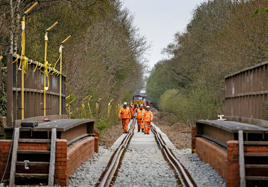Project Speed is Network Rail’s programme to halve the time it takes to make things happen… and slash the costs. It coined the term ‘Minimum Viable Product’.
Two years in, one scheme has been completed to these principles: the Dartmoor Line between Exeter and Okehampton. It was delivered early and significantly under budget.
But during those two years, much has altered. Project Speed was not designed to deal with the rampant inflation that now threatens to undermine the viability of other enhancement schemes.
It was established before the Treasury turned the screw on railway finances, squeezing the opportunities for further projects. Before energy costs went through the roof. And before a long, hot summer of industrial action centred on the reform of working practices coupled with below-inflation pay rises.
Now economic recession is looming. This will further dampen passenger demand that has not recovered from the pandemic. It’s highly likely that some of the schemes destined for the Project Speed treatment will be trimmed from the list.
“Speed originally was about halving the time and curtailing the cost,” says Cara Murphy, client director for Great British Railways at consultants Atkins.
“Then it became halving the cost and curtailing the time. Now I think it’s halving the time and halving the cost!
“It’s going to be very difficult. The investment pipeline is uncertain. Speed needs to be employed in a more widespread way, and not simply used as a tool on a limited number of major enhancements.
“You can apply the principles to maintenance and renewals, but that is not being done at the moment. Network Rail knows it is the right thing to do, but not much of the organisation has got around to doing it yet.”
“The concept has not changed at all,” counters Christian Irwin, Network Rail’s Rail Investment Centre of Excellence director, and previously the person in charge of the Okehampton project.
“Halve the time and slash the budget. We must get the most out of every single pound we spend.
“There is a finite amount of funding available. For every pound less we can spend on investment, there is more money to be spent on the rail network, or to be spent elsewhere in the UK.
“We have to recognise that Government investment is going to become increasingly challenging. We need to become more affordable.
“Speed was about how to tackle inefficiency in projects. How to break down the way we do things - the processes and standards that aren’t relevant on some of our work - and change the way rail spending is focused.”
There were six trial projects. The list then expanded to 28.
“Not all of them are live now, because the spending review is likely to reduce the amount we spend,” concedes Irwin.
“Across those 16 live programmes, we have seen in excess of £3 billion knocked off the anticipated final cost of those projects. We are forecasting savings of over 633 months across the projects. That’s £3bn we are not asking from Government for enhancement.”
The total combined spend of those 16 projects is £11.6bn.
According to Project Speed’s promotional material, it will “empower all of us to be revolutionary in our thinking”. That sounds like a neat line of superficial management gobbledygook. Dig a little deeper, and it means challenging standards and creating efficiencies through procurement, governance, assurance and timetabling - much of the saving comes not from the materials put into the ground, but from the planning and administration beforehand.
The ‘experiment’ ended on March 31. It has, according to Network Rail, produced “a new toolset, skillset and mindset”. Now the plan is to extend this to all enhancement and renewal projects.














